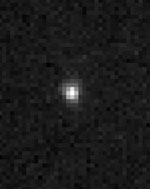
Image credit: Hubble
Astronomers poring over 35 NASA Hubble Space Telescope images of the solar system’s farthest known object, unofficially named Sedna, are surprised that the object does not appear to have a companion moon of any substantial size.
This unexpected result might offer new clues to the origin and evolution of objects on the far edge of the solar system.
When Sedna’s existence was announced on March 15, its discoverer, Mike Brown of Caltech, was so convinced it had a satellite that an artist’s concept of Sedna released to the media included a hypothetical moon.
Brown’s prediction was based on the fact that Sedna appears to have a very slow rotation that could best be explained by the gravitational tug of a companion object. Almost all other solitary bodies in the solar system complete a spin in a matter of hours.
“I’m completely baffled at the absence of a moon,” says Brown. “This is outside the realm of expectation and makes Sedna even more interesting. But I simply don’t know what it means.”
Immediately following the announcement of the discovery of Sedna, astronomers turned the Hubble Space Telescope toward the new planetoid to search for the expected companion moon. The space-based platform provides the resolving power needed to make such precision measurements in visible light. “Sedna’s image isn’t stable enough in ground-based telescopes,” says Brown.
Surprisingly, the Hubble images taken March 16 with the new Advanced Camera for Surveys only show the single object Sedna, along with a faint, very distant background star in the same field of view.
“Despite HST’s crisp view (equivalent to trying to see a soccer ball 900 miles away), it still cannot resolve the disk of mysterious Sedna,” says Brown. This would place an upper limit in the object’s size of being approximately three-quarters the diameter of Pluto, or about 1,000 miles across.
But Brown predicted that a satellite would pop up as a companion “dot” in Hubble’s precise view. The object is not there, though there is a very small chance it might have been behind Sedna or transiting in front of it, so that it could not be seen separately from Sedna itself in the Hubble images.
Brown based this prediction on his earlier observations of apparent periodic changes in light reflecting from Sedna’s mottled surface. The resulting light curve gives a long rotation period exceeding 20 days (but not greater than 50 days). If true, Sedna would be the slowest rotating object in the solar system after Mercury and Venus, whose slow rotation rates are due to the tidal influence of the Sun.
One easy way out of this dilemma is the possibility that the rotation period is not as slow as the astronomers thought. But even with a careful reanalysis the team remains convinced that the period is correct. Brown admits, “I’m completely lost for an explanation as to why the object rotates so slowly.”
Small bodies like asteroids and comets typically complete one rotation in a matter of hours. Pluto’s rotation has been slowed to a relatively leisurely six-day period because Pluto is tidally locked to the revolution period of its satellite Charon. Hubble easily resolves Pluto and Charon as two separate bodies. NASA’s forthcoming James Webb Space Telescope will provide a platform for further high-resolution studies of the infrared light from such distant, cold bodies in our solar system.
The Space Telescope Science Institute (STScI) is operated by the Association of Universities for Research in Astronomy, Inc. (AURA), for NASA, under contract with the Goddard Space Flight Center, Greenbelt, MD. The Hubble Space Telescope is a project of international cooperation between NASA and the European Space Agency (ESA).
Original Source: Hubble News Release
